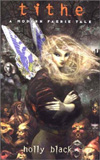Tithe, A Modern Faerie Tale

Black, Holly. Tithe, A Modern Faerie Tale. New York: Simon and Shuster, 2002. ISBN 0689849249, hc, 320 pp., $16.95.

(This review originally appeared in Mythprint 39:12 (#249) in December 2002.)
Reviewed by Emily Lauer
I used to hate the formula reviews — you know, take one part Talking Heads, three parts They Might be Giants and stir and you have Hot New Band! — but now, after just finishing Tithe by Holly Black, I see the wisdom of such a method. Because Tithe, for all that it is new and unique, can be easily described with this kind of formula. I was reminded strongly of Weetzie Bat, by Francesca Lia Block, and also of The Moorchild, by Eloise McGraw.
If you adored Weetzie Bat and wished it was longer, Tithe has a similar tone in many ways and is several times the length of Weetzie Bat. As in Block’s book, Tithe¹s characters seem realistic — they are teenagers with seedy, imperfect lives, who inhabit a world of disappointing parents and not fitting in. The sense of place is astute in both as well — Block with her Los Angeles dreamscape and Black with her polluted and cruel New Jersey.
The plot of Tithe is fairly complex for its intended age range, 12-14, but I don’t think any girls (and this is most decidedly a girl’s book) will be deterred by that complexity. The main character, Kaye, is an engaging one — a misfit who turns out to be a changeling, and, like the title moorchild in McGraw’s book, goes underground to discover her roots. The drama and action are mostly there, in the faery world, where Kaye must discover everybody’s loyalties and try to stay alive. Black creates a believable faery world informed by A Midsummer Night’s Dream, with court politics and feasts. Her faery and human characters interact, but seem doomed to misunderstand and hurt each other, and Black leaves us with an ending that begs for a sequel.
One of the things that sets Tithe apart from its predecessors in the same genre is its literary bent. Not only does Black open each chapter with a well-chosen quote, her characters are well-read, and refer to fantasy fiction of all mediums. Comic books, prose books, television, all are consumed by Kaye and her cohorts. The benefits of this are two-fold: one, it makes the characters easier for the reader to identify with, as they, too, inhabit a world where you can read a Sandman comic and watch Star Trek; and two, it introduces the reader to the very texts that have influenced the author.
So if I was to use the formula: Take the ambiance of Weetzie Bat, part of the plot of Moorchild, add two parts fangirl and one part Shakespearean rhetoric, place in New Jersey and stir; I would not be far from the truth.
